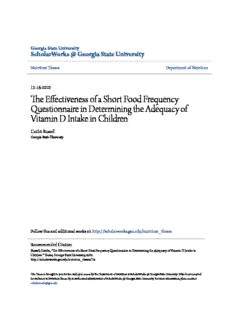
The Effectiveness of a Short Food Frequency Questionnaire in Determining the Adequacy of ... PDF
Preview The Effectiveness of a Short Food Frequency Questionnaire in Determining the Adequacy of ...
Georgia State University ScholarWorks @ Georgia State University Nutrition Theses Department of Nutrition Fall 12-15-2010 The Effectiveness of a Short Food Frequency Questionnaire in Determining the Adequacy of Vitamin D Intake in Children Caitlin Russell Georgia State University Follow this and additional works at:https://scholarworks.gsu.edu/nutrition_theses Part of theNutrition Commons Recommended Citation Russell, Caitlin, "The Effectiveness of a Short Food Frequency Questionnaire in Determining the Adequacy of Vitamin D Intake in Children." Thesis, Georgia State University, 2010. https://scholarworks.gsu.edu/nutrition_theses/18 This Thesis is brought to you for free and open access by the Department of Nutrition at ScholarWorks @ Georgia State University. It has been accepted for inclusion in Nutrition Theses by an authorized administrator of ScholarWorks @ Georgia State University. For more information, please contact [email protected]. NOTICE TO BORROWERS All theses deposited in the Georgia State University library must be used in accordance with the stipulations prescribed by the author in the preceding statement. The author of this thesis is: Caitlin S. Russell 3978 Land O’ Lakes Drive Atlanta, GA 30342 The director of this thesis is: Anita M. Nucci, PhD, RD, LD Assistant Professor and Graduate Program Director Division of Nutrition, School of Health Professions College of Health and Human Sciences Georgia State University Atlanta, Georgia 30302 VITA Caitlin S. Russell ADDRESS: 3978 Land O’ Lakes Drive Atlanta, GA 30342 EDUCATION: M.S. 2010 Georgia State University Health Sciences B.A. 1994 Sweet Briar College French PROFESSIONAL EXPERIENCE: Director, Tradeshows 2001-2004 AMC, Inc., Atlanta, GA Web & Graphic Designer 2000-2001 ExpoExchange, LLC, Decatur, GA Executive Director, International Development 1997-2000 AMC, Inc., Atlanta, GA Assistant English Teacher 1994-1996 Japan Exchange & Teaching Program, Kimitsu, Japan PROFESSIONAL SOCIETIES AND ORGANIZATIONS: Treasurer, Greater Atlanta Dietetic Association 2010-present American Dietetic Association 2006-present Georgia Dietetic Association 2006-present Greater Atlanta Dietetic Association 2006-present AWARDS AND PUBLICATIONS: American Dietetic Association’s Outstanding Dietetics Student Award 2010 Georgia State University’s Outstanding Didactic Program in 2010 Dietetics Award – Graduate Student Georgia Dietetic Association’s Outstanding Student – Didactic Program 2010 Dean’s List – Georgia Perimeter College Dunwoody Center 2004 Dean’s List – Georgia Perimeter College Clarkston Campus 2004 The Georgia State University Signal, Vol. 74, Issue 27; 2007 Fast, cheap and healthy recipes ABSTRACT THE EFFECTIVENESS OF A SHORT FOOD FREQUENCY QUESTIONNAIRE IN DETERMINING THE ADEQUACY OF VITAMIN D INTAKE IN CHILDREN by Caitlin S. Russell Background: Studies have consistently found a high prevalence of vitamin D deficiency in adolescents. Few validated dietary intake assessment tools for vitamin D exist for adolescents. Objective: The aim of this study was to determine if a short food frequency questionnaire (SFFQ) can be used to effectively assess vitamin D intake in adolescents compared to a previously validated long food frequency questionnaire (LFFQ). Participants/setting: 140 healthy 6-12 year old (male n=81) Caucasian and African American (n=94) children from Pittsburgh, Pennsylvania completed a SFFQ and LFFQ at two time points 6 months apart. Main outcome measures: Reliability and validity of a SFFQ by comparison with a previously validated LFFQ for children and adolescents. Statistical analysis: Reliability, validity, sensitivity, specificity, positive, and negative predictive values were assessed using Pearson correlation coefficients. Results: Mean vitamin D intake from the SFFQ (range, 434 to 485 IU) was higher than the LFFQ (range, 320 to 378 IU). Overall association between the SFFQ and the LFFQ for vitamin D intake was modest (r=0.36, P<0.001). When stratified by race, the overall degree of association was weak for African Americans (r=0.26, P=0.001) and moderate for Caucasians (r=0.57, P<0.001). Overall reliability testing results were modest and significant for the LFFQ (r=0.28, P=0.002) and SFFQ (r=0.33, P<0.001). Association between mean vitamin D intake from LFFQs and SFFQs was used to determine validity. The association for validity was found to be modest (r=0.51, P<0.001). Sensitivity, specificity, positive predictive value, and negative predictive value for the SFFQ were 90%, 64%, 0.78, and 0.58, respectively. Conclusion: The SFFQ was found to be modestly valid and reliable in an early adolescent population. Associations between African Americans were not as strong as Caucasians which may be due to errors in reporting dietary consumption related to higher body weight. THE EFFECTIVENESS OF A SHORT FOOD FREQUENCY QUESTIONNAIRE IN DETERMINING THE ADEQUACY OF VITAMIN D INTAKE IN CHILDREN by Caitlin S. Russell A Thesis Presented in Partial Fulfillment of Requirements for the Degree of Master of Science in Health Sciences The College of Health and Human Sciences Division of Nutrition Georgia State University Atlanta, Georgia 2010 ACKNOWLEDGMENTS I owe my deepest gratitude to Dr. Anita Nucci for her patience, constant support and advisement throughout this process. I am honored to have received her invaluable insight into research publishing. I would also like to thank Dr. Vijay Ganji and Barbara Hopkins for their expert assistance in writing this thesis. Also, thank you to Barbara for her indispensible guidance throughout my graduate studies. I am grateful for Dr. Kumaravel Rajakumar and his staff for beginning the initial research and for their support while writing this manuscript. Finally, I am indebted to my husband Scott Russell and my daughters Eva and Julia for their encouragement and unwavering support during these past years. Without them and the rest of my loving family and friends, I literally could not have accomplished this. ii TABLE OF CONTENTS List of Tables ..................................................................................................................... iv Abbreviations .......................................................................................................................v Chapter I. INTRODUCTION .............................................................................................1 II. LITERATURE REVIEW ..................................................................................4 Vitamin D Requirements in Humans .................................................................4 Vitamin D Status in Children and Adolescents .................................................5 Dietary Assessment Methods in Children..........................................................7 24-Hour Dietary Recall .................................................................................9 Food Record ................................................................................................11 Food Frequency Questionnaire ...................................................................13 Table 1. Characteristics of studies that focused on vitamin D intake among adolescent populations .....................................................................................16 Vitamin D Intake in Children and Adolescents ...............................................17 References ........................................................................................................19 III. MANUSCRIPT IN STYLE OF JOURNAL ....................................................27 Author’s Page...................................................................................................28 Abstract ............................................................................................................30 Introduction ......................................................................................................32 Methods............................................................................................................35 Results ..............................................................................................................39 Discussion ........................................................................................................41 Conclusion .......................................................................................................50 Tables ...............................................................................................................51 References ........................................................................................................57 iii
Description: